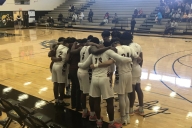You have /5 articles left.
Sign up for a free account or log in.

University of St. Thomas
The decision raised eyebrows among athletics pundits: a conference forcing out one of its member institutions over issues of “competitive parity.” Translation: the University of St. Thomas, a Roman Catholic college in Minnesota, was winning too much for its peers’ liking.
But St. Thomas’s “involuntary” separation from the Minnesota Intercollegiate Athletic Conference speaks to problems plaguing the National Collegiate Athletic Association's Division III that harken back a decade. Then, Division III institutions faced a schism: the small private colleges that traditionally dominated the division versus relative newcomers, which were often larger, more affluent institutions, some of which were interested in models akin to the upper leagues and doing away with athletic scholarship bans in Division III.
Dan McKane, commissioner of the MIAC, said the conference presidents felt that they and St. Thomas had clashing “philosophies” around athletics, which meant something different depending on which administrator you talked to. He said, though, that the conflict was similar to the one from 10 years ago.
“In Division III, there are more 450 institutions that don’t all look alike,” McKane said. “Every school has their own advantages. I think through the lens of our presidents, [St. Thomas’s] advantages were too great.”
St. Thomas was a charter member of the MIAC, helping found the conference in 1920. Rumblings about the university leaving began a long time ago, but presidents more formally started discussing the idea about two years ago, McKane said.
The debate largely centered around St. Thomas’s enrollment of roughly 6,200 undergraduate students, double many MIAC institutions, which many felt was unfair.
All 13 members of the MIAC are private colleges in Minnesota. In the last several years, St. Thomas “made some great choices,” said McKane -- investing money in athletics facilities and bringing in high-caliber coaches. The most significant of these hires was in 2008 with the football coach, Glenn Caruso, who has led the team to six conference titles and participation in two national championship games.
The Tommies’ football prowess did not go unnoticed, particularly after a brutal game in 2017, when St. Thomas trounced St. Olaf College, 97-0. The Minneapolis Star Tribune reported that this match was a catalyst for trying to kick out the university.
Being larger than the other MIAC members (with more money in their athletics budget) meant that St. Thomas could attract physically stronger, more talented football players -- to the point that some other presidents felt that the “the safety and well-being” of their teams were jeopardized, McKane said.
The St. Thomas men’s and women’s basketball teams, and the volleyball and softball teams, have also dominated the conference, winning more league championships than any other MIAC institution. St. Thomas won 47 percent of all MIAC championships -- both team and individual sports -- from 2003 to 2018.
St. Thomas wanted to stay. President Julie H. Sullivan met with other conference administrators, trying to persuade them that St. Thomas best fit in the MIAC. Her appeals didn’t work. Though an official vote never took place to remove it, St. Thomas was booted out, officials announced Wednesday.
“While this decision is extremely disappointing, we will continue to prioritize the welfare and overall experience of our student athletes,” Sullivan said in a statement. “They embrace and represent both academic and athletic excellence and are important contributors to our university’s culture. Additionally, our coaches share the values of advancing comprehensive excellence and are among the best in the country.”
Institutions would have left the conference en masse had St. Thomas not.
Nine institutions were needed to formally vote to remove St. Thomas, but most of them threatened to break off and form their own league, leaving three or four colleges with less money and resources to fend for themselves. St. Thomas administrators essentially saved the conference by agreeing to the other presidents’ demands.
“It does look wonky, but knowing the whole background, institutions need to find a good fit,” McKane said. “We want to make sure that the institutions that we’re with can find success. Ultimately that was the presidents’ goal. And clearly this does look very off, but that was not the intention.”
St. Thomas will be allowed to play in the MIAC through spring 2021. It did not break any rules and leaves the conference in good standing, the MIAC said in a statement.
The university now must find a new conference or play independently, which would make scheduling difficult. If it remains in Division III, a likely home would be the Wisconsin Intercollegiate Athletic Conference, which only has Wisconsin institutions but does not forbid out-of-state institutions from joining.
St. Thomas could join Division II or Division I -- the jump to Division I would be particularly costly. An institution must stay in Division II for five years before even attempting to move to Division I.
Dan Dutcher, vice president for Division III, forwarded a request for comment to the National Collegiate Athletic Association, which did not respond.
St. Thomas’s dilemma recalls the split 10 years ago in Division III, because at the time, some institutions wanted to break off and create a Division IV, or a subdivision with a lesser designation.
Division III institutions were already diverse in terms of enrollment, with some universities having 400 undergraduates and some having up to 40,000 at the time. And while Division III colleges can’t offer athletic scholarships, they can extend merit-based scholarships, which have been used to lure athletes to certain institutions. Some Division III colleges have been accused of bending the rules by offering athletes large merit-based scholarships, which deepens the divides between the haves and have-nots among Division III institutions.
Many institutions at the time did not want to be associated with a Division IV because Division III is already considered less prestigious than the upper two divisions, and the shift would likely have made recruitment even harder for less wealthy institutions.
“The larger schools, generally among the newest to the division, wanted to offer athletic scholarships and also to do more to emphasize athletic competition, moving closer to the DI approach,” said Josephine R. Potuto, former member of the NCAA Division I infractions committee and Richard H. Larson Professor of Constitutional Law at the University of Nebraska at Lincoln. “The smaller schools wanted to retain what they saw as an integrative model of academics and athletics -- athletics offered because of the benefit to students from participation and not to attract fans and donors and etc.”
John Thelin, professor of higher education and public policy in the University of Kentucky College of Education, said that some ambitious small colleges have tried joining the National Association of Intercollegiate Athletics, which does allow its institutions to have athletic scholarships
“What a shame that such a historic conference has this problem,” Thelin said.








